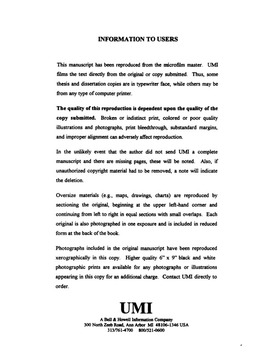| dc.contributor.advisor | Davis, Robert Con, | en_US |
| dc.contributor.author | Will, Bradley Alan. | en_US |
| dc.date.accessioned | 2013-08-16T12:30:10Z | |
| dc.date.available | 2013-08-16T12:30:10Z | |
| dc.date.issued | 1998 | en_US |
| dc.identifier.uri | https://hdl.handle.net/11244/5691 | |
| dc.description.abstract | Failure of understanding is the basis of Kant's theory of the sublime. As shown in the Critique of Judgement, this painful experience allows insight into the sublime. The failure delineates the limitations of our capacity to understand, but where our faculty of understanding fails to grasp an object, our faculty of reason generates an abstract idea whereby we can conceive of the object as an abstract form. This abstract conception is a form of negative knowledge--awareness of a gap in understanding. Thus, failure to grasp the given object creates awareness of the existence of that which exceeds understanding--we experience the sublime. | en_US |
| dc.description.abstract | This sublimity is found in Lovecraft's "The Colour Out of Space, " "The Call of Cthulhu" and "The Dreams in the Witch House." In addition to the sublimely ungraspable monoliths of the 2001 cycle, Clarke presents the supramundane in the guise of the "Overlords" and "Overmind" of Childhood's End. Further, the sublime is engaged by the artificial intelligences lurking in the cyberspace of Gibson's Matrix trilogy, Neuromancer, Count Zero, and Mona Lisa Overdrive. | en_US |
| dc.description.abstract | The supramundane is a subgenre of science fiction characterized by depictions of other-worldly phenomena which, though not supernatural, defy understanding because they come from outside the sphere of our mundane world. Though H. P. Lovecraft, Arthur C. Clarke, and William Gibson write about different aspects of science fiction, many of their works depict the supramundane. | en_US |
| dc.description.abstract | The supramundane presents a vision of human scientific understanding counter to that of conventional science fiction which suggests that our scientific knowledge has limitless potential. The supramundane places humanity in a hostile universe which cannot and will never be controlled or understood. | en_US |
| dc.description.abstract | The monoliths of Clarke's 2001: A Space Odyssey are familiar examples of the supramundane. These black, featureless slabs are products of a non-human, higher-order technology. They behave unexpectedly, violate scientific principles and defy scientific analysis. Thus, the monoliths cause a failure of the human faculty of understanding. | en_US |
| dc.format.extent | vii, 207 leaves : | en_US |
| dc.subject | Science fiction. | en_US |
| dc.subject | Literature, American. | en_US |
| dc.subject | Clarke, Arthur C. (Arthur Charles), 1917-2008 Criticism and interpretation. | en_US |
| dc.subject | Literature, English. | en_US |
| dc.subject | Gibson, William, 1948- Criticism and interpretation. | en_US |
| dc.subject | Literature, Modern. | en_US |
| dc.subject | Lovecraft, H. P. (Howard Phillips), 1890-1937 Criticism and interpretation. | en_US |
| dc.title | The "supramundane": The Kantian sublime in Lovecraft, Clarke, and Gibson. | en_US |
| dc.type | Thesis | en_US |
| dc.thesis.degree | Ph.D. | en_US |
| dc.thesis.degreeDiscipline | Department of English | en_US |
| dc.note | Source: Dissertation Abstracts International, Volume: 59-09, Section: A, page: 3451. | en_US |
| dc.note | Chair: Robert Con Davis. | en_US |
| ou.identifier | (UMI)AAI9905607 | en_US |
| ou.group | College of Arts and Sciences::Department of English | |
